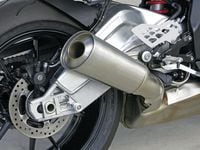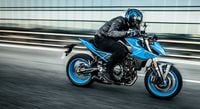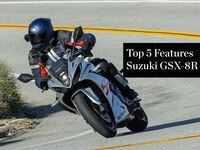You’ve had your new bike for barely a day, and already your riding buddies are telling you what’s wrong with it. According to them, the cutting-edge suspension, brakes, exhaust, and tires are actually cheap, disposable junk that’s holding you back from fulfilling your true destiny as a canyon-carving god. You know they’re full of it, right?
Don’t tear apart your new bike just yet. First make sure you’re getting all it has to offer in stock trim. Let’s start with suspension. The more adjustability the stock suspension has, the more chances there are for you to get it wrong if you go at it like a chimp. The right setting may be in there, but it can take work to find it, and a bit more work to fine-tune it to your weight, riding style, and the quality of your roads. Always begin with the baseline settings in the owner’s manual. Ride the bike on a variety of roads long enough to decide what you don’t like about the way it handles. Then change the settings one at a time, in small increments, until handling or ride quality improves. You’ll know you’ve gone past the sweet spot if gets better, then worse. Backtrack to the last good setting and leave it there.
Sometimes manufacturers miss the mark, and provide suspension far too stiff or soft for your weight. This is the most justifiable reason for replacing or upgrading the stock suspension so early in the bike’s life. Understand, as well, that suspension wears with the miles, so one setting might not hold after a few thousand miles. Also, be prepared to rework your suspension settings if you change brands or models of tires.
Everybody seems to want more performance, and replacing the stock exhaust with a free-flowing aftermarket system has been a popular way to get it. A couple of points here: First, today’s stock exhausts are incredibly good, and the gains with just a simple slip-on have become razor thin (if you just want it to be louder, say so; don’t lean on the performance crutch). Second, to get the most performance, you will want to either get a new map for the ECU (if that’s even possible) or add an aftermarket injection module. Depending on the bike, the cost per horsepower gained can be brutally high.
The best advice is simply to wait and experience the bike in bone-stock form before throwing down for performance upgrades. And remember that the ultimate performance limiter is the component holding the handlebars. Unless your last name is Hayes or Hayden, odds are you can’t use all the performance your bike has anyway. Rather than pop for more horsepower, invest that money in a riding school.

/cloudfront-us-east-1.images.arcpublishing.com/octane/T2WRHM2RYVENHKM4TJKPGJHQZM.jpg)
/cloudfront-us-east-1.images.arcpublishing.com/octane/Y3L3XK4D5NHANIPLASAFHE4FAY.jpg)
/cloudfront-us-east-1.images.arcpublishing.com/octane/RP2FUYOZ4JDGRC666UKCWDLWPE.jpg)
/cloudfront-us-east-1.images.arcpublishing.com/octane/HT5PNEQC7VDXZHNYECPSKSYGTU.jpg)
/cloudfront-us-east-1.images.arcpublishing.com/octane/VN63PLIOMJCDJC3PWLIJQI5YHQ.jpg)
/cloudfront-us-east-1.images.arcpublishing.com/octane/SYIS3UGL7BGB5NEN5GSIVSFISM.jpg)
/cloudfront-us-east-1.images.arcpublishing.com/octane/H2NJJMCBSZCVHNDOGUQILJFMX4.jpg)
/cloudfront-us-east-1.images.arcpublishing.com/octane/K25WVPRMCVEDZJ7ZJK4BWE374Y.jpg)
/cloudfront-us-east-1.images.arcpublishing.com/octane/TQQGTGULURF5TOSK4FHQX7QKWY.jpg)

/cloudfront-us-east-1.images.arcpublishing.com/octane/THZ26BIH45AYBHU6WB527JTTCU.jpg)
/cloudfront-us-east-1.images.arcpublishing.com/octane/7OWQWAWJBFCGTAYQWBMWGNMNB4.jpg)
/cloudfront-us-east-1.images.arcpublishing.com/octane/4G5XKCDIHRCGRHVF7OPORG7ZX4.jpg)
/cloudfront-us-east-1.images.arcpublishing.com/octane/D2BDYKKNZ5GRHGDMI4PZTGRMME.jpg)

/cloudfront-us-east-1.images.arcpublishing.com/octane/UAY4WSZPOFDQRP4MCEXAKDFQOQ.jpg)

/cloudfront-us-east-1.images.arcpublishing.com/octane/X5CE3KSJHZHM5CUFGPZ7U26WB4.jpg)
/cloudfront-us-east-1.images.arcpublishing.com/octane/COWLTPGFAFGDDGJCTENYMA4VJM.jpg)
/cloudfront-us-east-1.images.arcpublishing.com/octane/H3PKUGPSUJFTND4RFPSI4OIDCE.jpg)
/cloudfront-us-east-1.images.arcpublishing.com/octane/UHGQA3MQDFCA3HLBWF7S76WH6Y.jpg)
/cloudfront-us-east-1.images.arcpublishing.com/octane/Q5EORCSTNFAVBJC4IYUHIKJTXQ.jpg)
/cloudfront-us-east-1.images.arcpublishing.com/octane/XIJ5FUFSP5A3NL7MOVZGJXAHC4.jpg)
/cloudfront-us-east-1.images.arcpublishing.com/octane/V5NZN3CGS5B5PPYFYJHIPAU5S4.jpg)